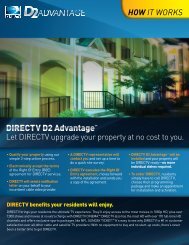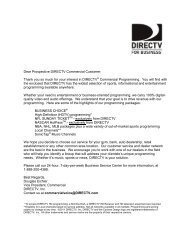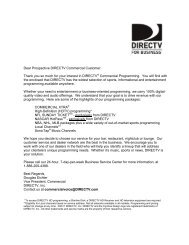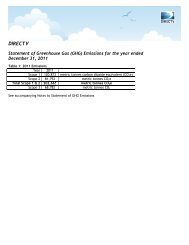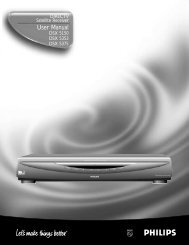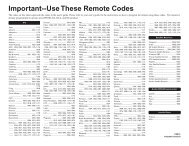DSX 5500 DSX 5540 DIRECTV® Receiver User Manual
DSX 5500 DSX 5540 DIRECTV® Receiver User Manual
DSX 5500 DSX 5540 DIRECTV® Receiver User Manual
You also want an ePaper? Increase the reach of your titles
YUMPU automatically turns print PDFs into web optimized ePapers that Google loves.
<strong>DSX</strong><strong>5500</strong>_<strong>5540</strong> 11/13/02 12:21 PM Page 3<br />
Safety Instructions - Read Before Operating Equipment<br />
WARNING: TO PREVENT FIRE OR SHOCK HAZARD, DO NOT<br />
EXPOSE ANY ELECTRICAL EQUIPMENT TO RAIN OR MOISTURE.<br />
1. Read Instructions – All the safety and operating instructions<br />
should be read before the appliance is operated.<br />
2. Retain Instructions – The safety and operating instructions<br />
should be retained for future reference.<br />
3. Heed Warnings – All warnings on the appliance and in the operating<br />
instructions should be adhered to.<br />
4. Follow Instructions – All operating and use instructions should<br />
be followed.<br />
5. Attachments – Do not use attachments not recommended by the<br />
manufacturer as they may cause hazards.<br />
6. Water and Moisture – Do not use this product near water –<br />
for example, near a bath tub, wash bowl, kitchen sink, or laundry<br />
tub, in a wet basement, near a swimming pool, etc.<br />
7. Accessories – Do not place this product on an unstable cart,<br />
stand, tripod, bracket, or table. The product may fall, causing serious<br />
injury to a child or adult, and serious damage to the appliance.<br />
Use only with a cart, stand, tripod, bracket, or table recommended<br />
by the manufacturer or sold with the product. Any mounting of the<br />
appliance should follow the manufacturer's instructions, and should<br />
use a mounting accessory recommended by the manufacturer.<br />
7A. An appliance and cart combination should be moved with<br />
care. Quick stops, excessive force, and uneven surfaces may<br />
cause the appliance and cart combination to overturn.<br />
8. Ventilation – Slots and openings on the cabinet are provided for<br />
ventilation and to ensure reliable operation of the product and to<br />
protect it from overheating. These openings must not be blocked<br />
or covered. The openings should never be blocked by placing the<br />
product on a bed, sofa, rug, or other similar surface. This product<br />
should not be placed near or over a radiator or heat register. This<br />
product should not be placed in a built-in installation such as a<br />
bookcase or rack unless proper ventilation is provided or the manufacturer’s<br />
instructions have been adhered to.<br />
9. Power Sources – This product should be operated only from the<br />
type of power source indicated on the marking label. If you are not<br />
sure of the type of power supply to your home, consult your appliance<br />
dealer or local power company.<br />
10. Grounding or Polarization – This product is equipped with a<br />
polarized alternating-current line plug (a plug having one blade<br />
wider than the other). This plug will fit into the power outlet only<br />
one way. This is a safety feature. If you are unable to insert the plug<br />
fully into the outlet, try reversing the plug. If the plug should still fail<br />
to fit, contact your electrician to replace your obsolete outlet. Do<br />
not defeat the safety purpose of the polarized plug.<br />
11. Power Cord Protection – Route power supply cords so that<br />
they are not likely to be walked on or pinched by items placed<br />
upon or against them. Pay particular attention to cords at plugs,<br />
convenience receptacles, and the point where they exit from the<br />
appliance.<br />
12. Outdoor Antenna Grounding – If an outside antenna or cable<br />
system is connected to the product, be sure the antenna or cable<br />
system is grounded to provide protection against voltage surges<br />
and built-up static charges.<br />
Section 810 of the National Electrical Code, ANSI/NFPA 70, provides<br />
information with regard to proper grounding of the mast and<br />
supporting structure, grounding of the lead-in wire to an antenna<br />
discharge unit, size of grounding conductors, location of antennadischarge<br />
unit, connection to grounding electrodes, and requirements<br />
for the grounding electrode. See Figure A.<br />
13. Phone Line Use – Avoid using a telephone (other than a cordless<br />
type) during an electrical storm. There may be a remote risk of<br />
electric shock from lightning. Do not use the telephone to report a<br />
gas leak in the vicinity of the leak.<br />
14. Lightning – For added protection for this product during a lightning<br />
storm or when it is left unattended and unused for long periods<br />
of time, unplug it from the wall outlet and disconnect the<br />
antenna or cable system. This will prevent damage to the product<br />
from lightning and power line surges.<br />
3<br />
15. Power Lines – An outside antenna system should not be located<br />
in the vicinity of overhead power lines or other electric light or<br />
power circuits, or where it can fall onto such power lines or circuits.<br />
When installing an outside antenna system, extreme care<br />
should be taken to keep from touching such power lines or circuits<br />
as contact with them might be fatal. Refer to Satellite Dish Antenna<br />
Assembly & Alignment Guide.<br />
16. Overloading – Do not overload wall outlets and extension cords<br />
as this can result in a risk of fire or electric shock.<br />
17. Object and Liquid Entry – Never push objects of any kind into<br />
this product through openings as they may touch dangerous voltage<br />
points or short-out parts that could result in a fire or electric<br />
shock. Never spill liquid of any kind on the product.<br />
18. Servicing – Do not attempt to service this product yourself, as<br />
opening or removing covers may expose you to dangerous voltage<br />
or other hazards. Refer all servicing to qualified service personnel.<br />
19. Damage Requiring Service – Unplug this product from the wall<br />
outlet and refer servicing to qualified service personnel under the<br />
following conditions:<br />
a. When the power supply cord or plug is damaged.<br />
b. If liquid has been spilled, or objects have fallen into the product.<br />
c. If the product has been exposed to rain or water.<br />
d. If the product does not operate normally when following the operating<br />
instructions. Adjust only those controls that are covered by the<br />
operating instructions, as an improper adjustment of other controls<br />
may result in damage and will often require extensive work by a<br />
qualified technician to restore the product to its normal operation.<br />
e. If the product has been dropped or the cabinet has been damaged<br />
in any way.<br />
f. When the product exhibits a distinct change in performance –<br />
this indicates a need for service.<br />
20. Replacement Parts – When replacement parts are required, be<br />
sure the service technician has used replacement parts specified by<br />
the manufacturer or which have the same characteristics as the<br />
original part. Unauthorized substitutions may result in fire, electric<br />
shock or other hazards.<br />
21. Safety Check – Upon completion of any service or repairs to this<br />
product, ask the service technician to perform safety checks to<br />
determine that the product is in proper operating condition.<br />
22. Carts and Stands – The appliance should be used only with a<br />
cart or stand recommended by the manufacturer.<br />
23. Heat – The product should be situated away from heat sources<br />
such as radiators, heat registers, stoves, or other products that<br />
produce heat.<br />
Operating Temperature: 40 to 110°F<br />
Storage Temperature: 15 to 155°F<br />
Figure A





